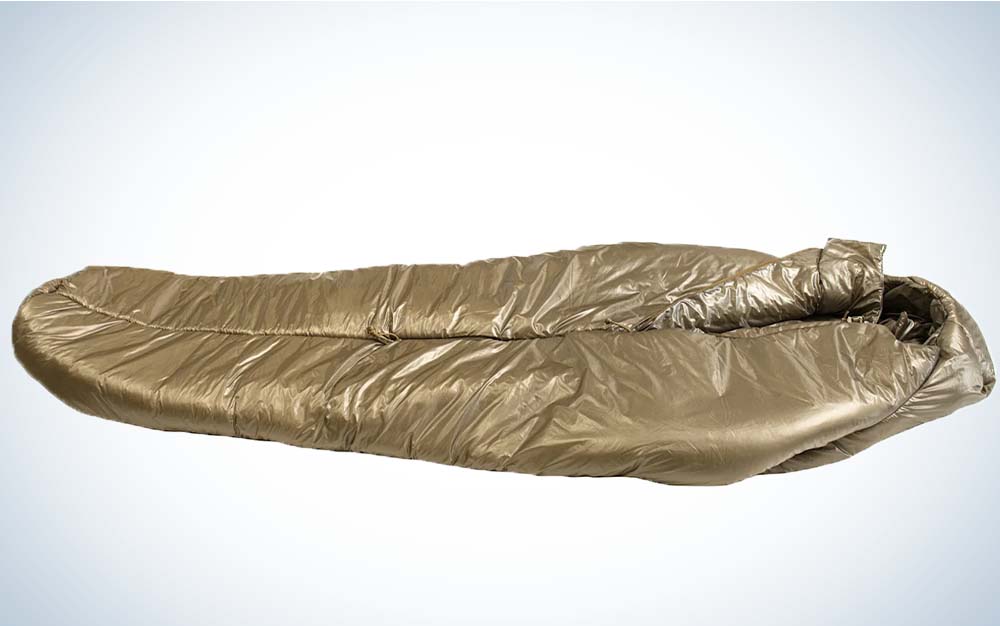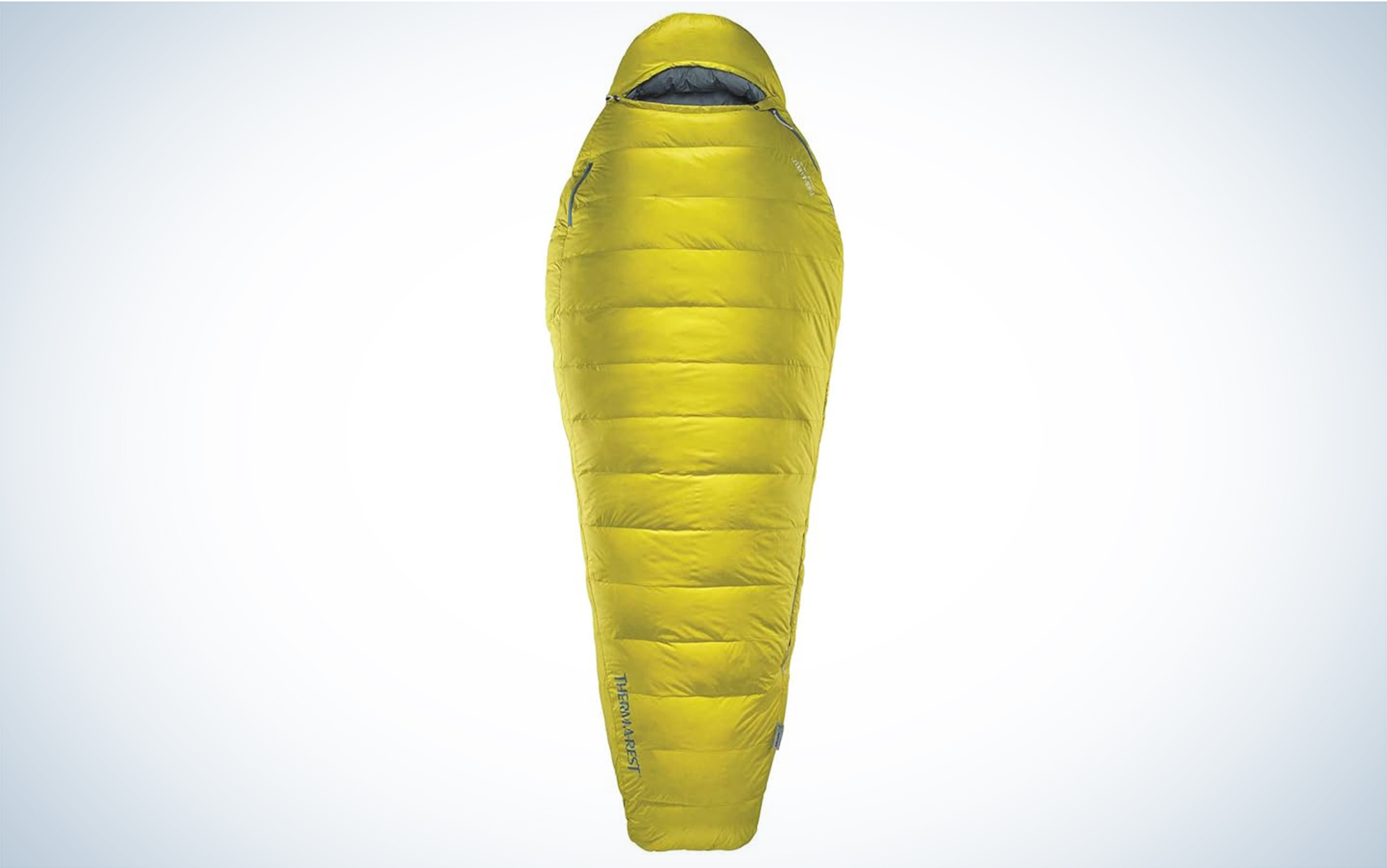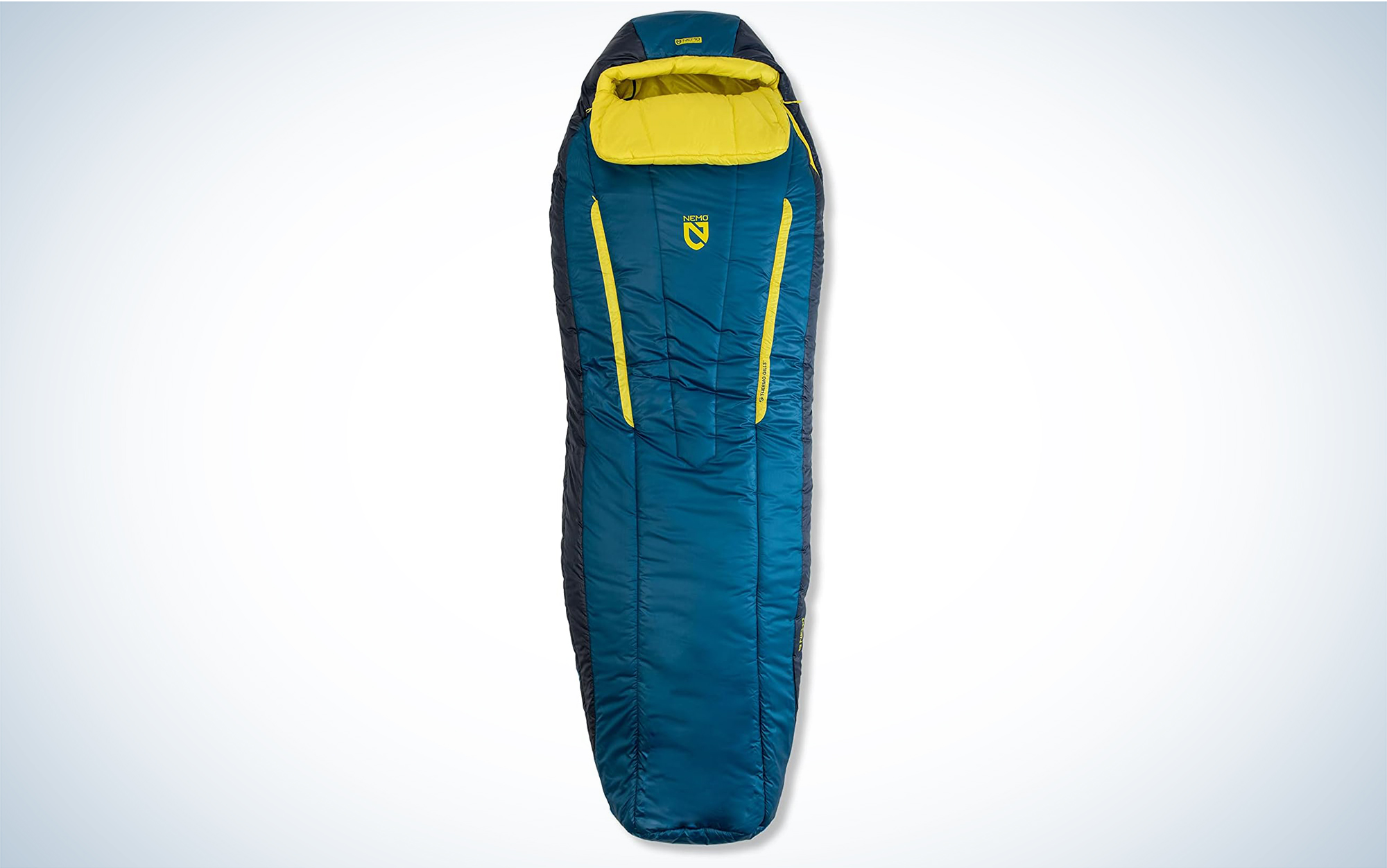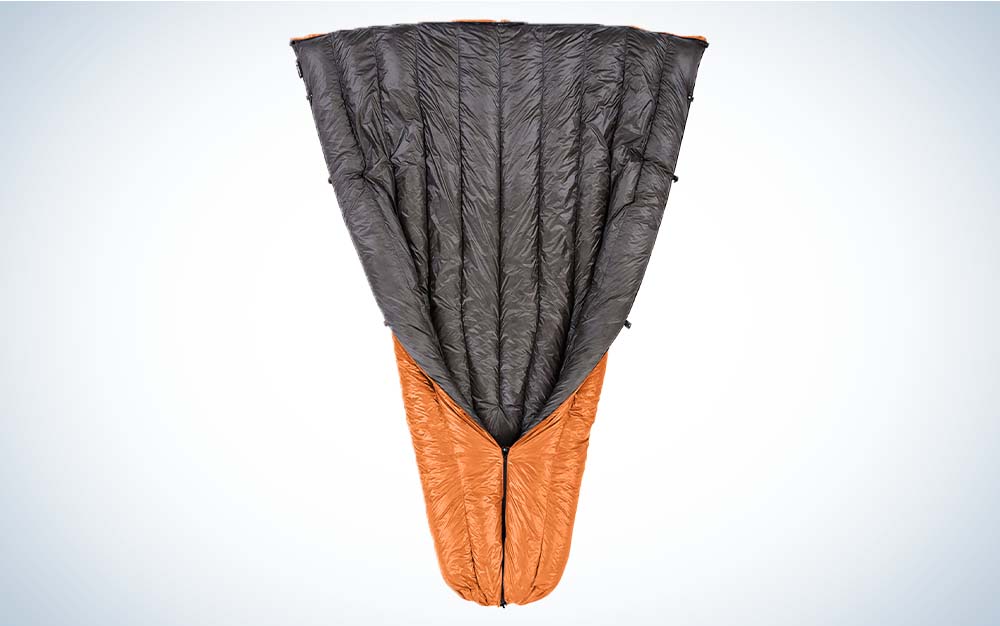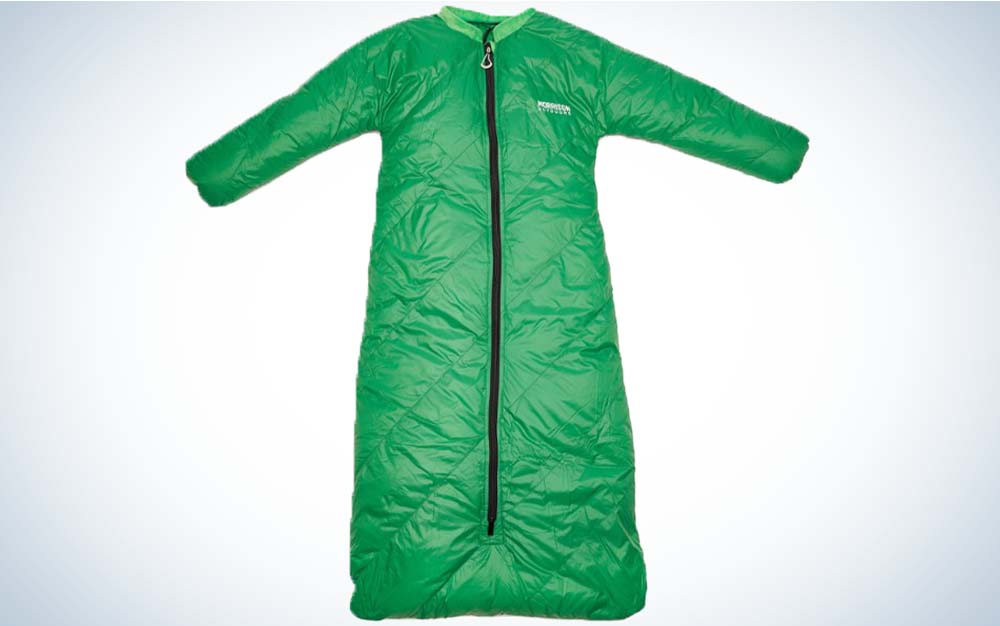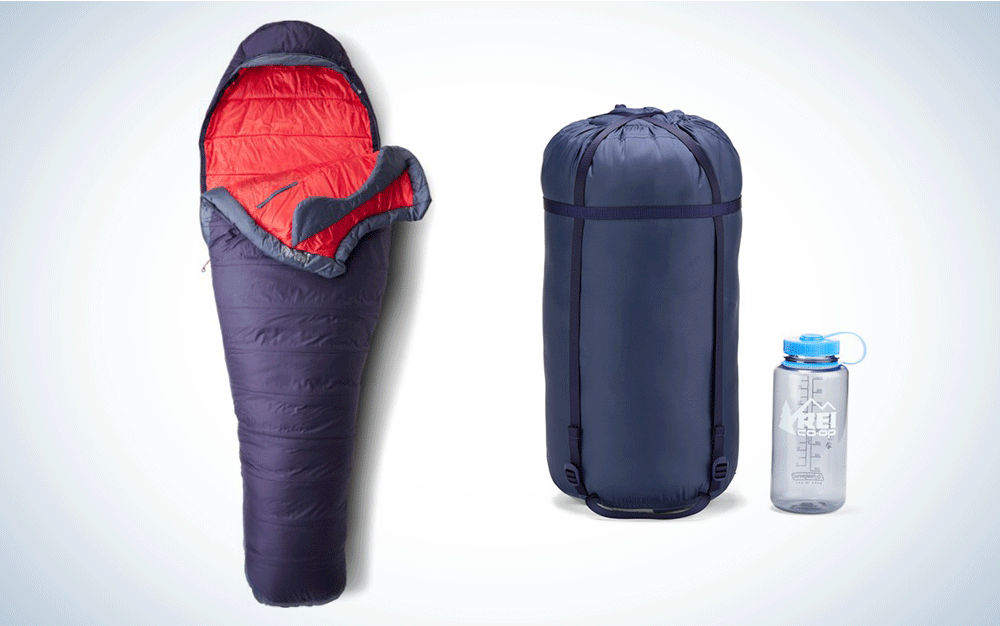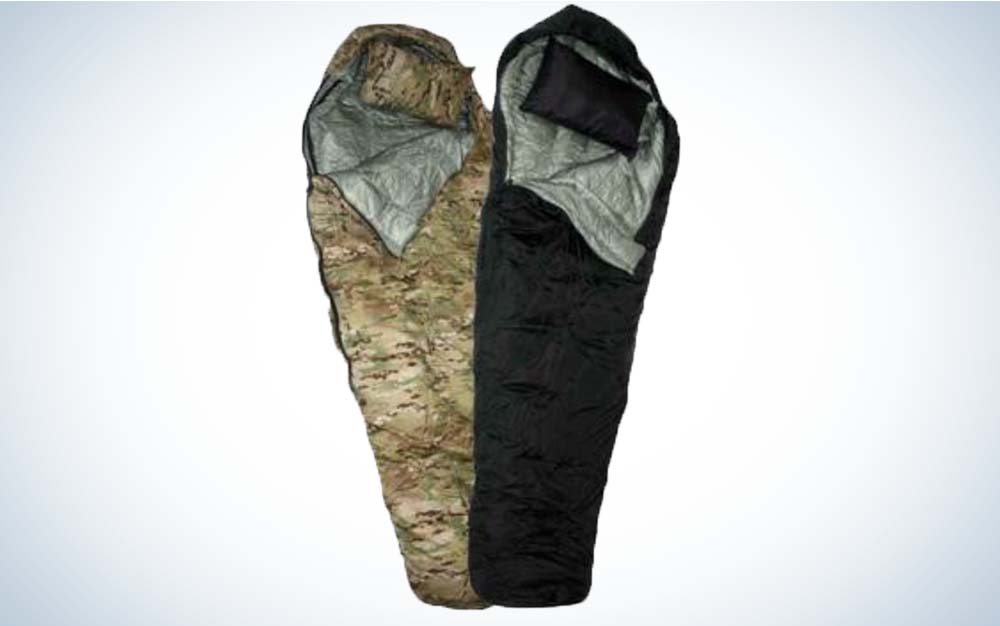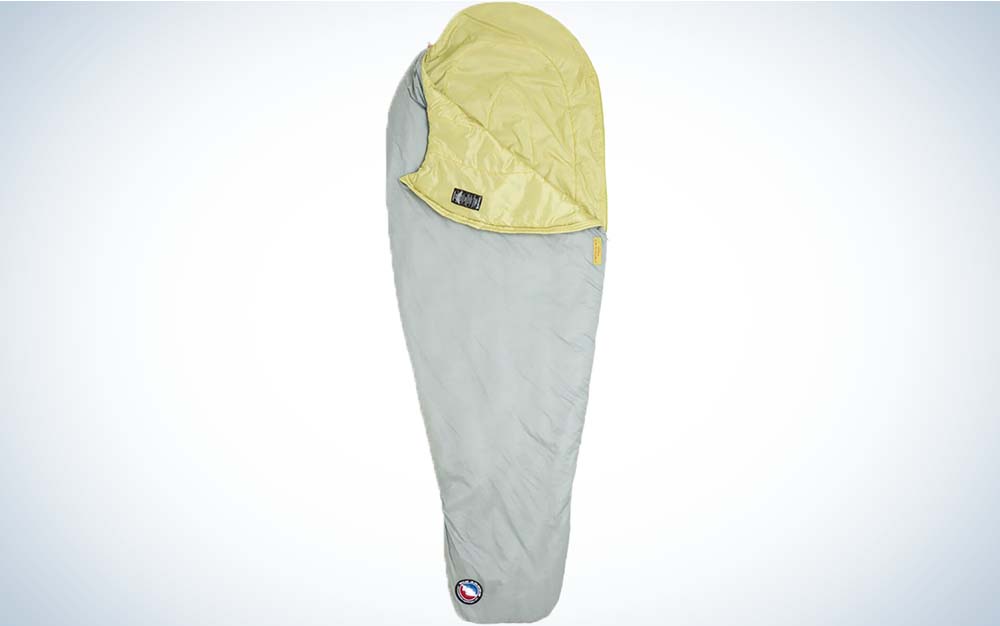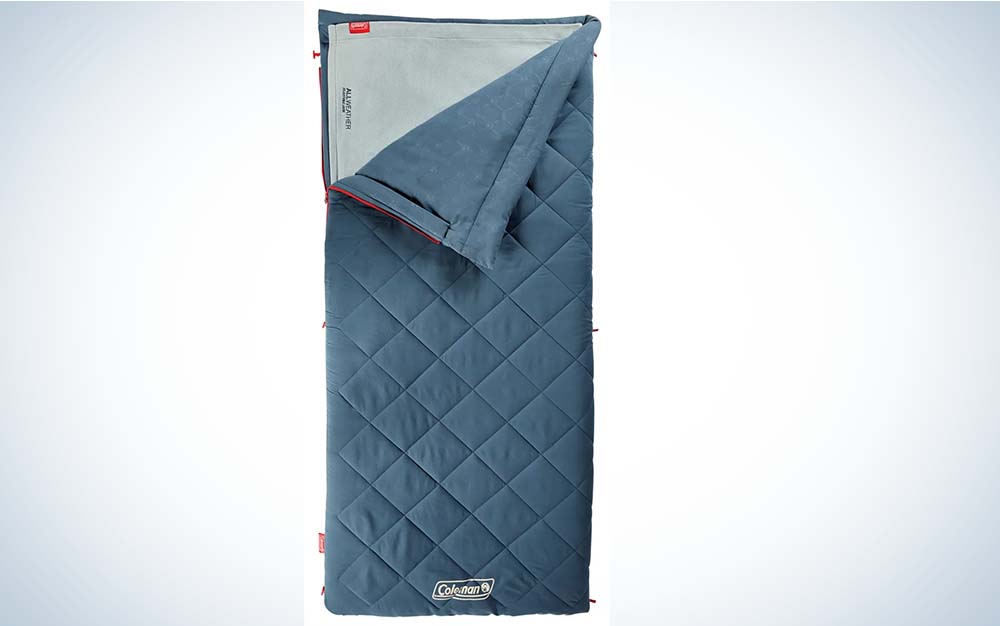We may earn revenue from the products available on this page and participate in affiliate programs. Learn More ›
Updated Sep 29, 2023 6:59 PM
Think about your first camping trip, your coldest or rainiest backpacking trip, or a hunt where you didn’t expect to have to stay an extra night. What makes or breaks moments like these is a warm, dry core—in other words, the best sleeping bag for the situation. A comfortable, quality sleep is ideal, and staying warm through the night is necessary. So, four Outdoor Life team members—from Minnesota, Colorado, Washington, and Alaska—compiled our top picks to keep you safe during (and help you enjoy) your next hunting, backpacking, or camping trip.
All of these picks have stood the test of time. So, figure out what trips you’re looking to take, and use this list to help you buy your first sleeping bag, or get a much-needed upgrade.
How We Picked the Best Sleeping Bags
The Outdoor Life team covers most regions of the U.S. and has decades of experience sleeping outside in the snow, on backcountry hunts, or at frontcountry campgrounds with their families. So, all of the sleeping bags on this list have been put through the wringer and proved to stand out in the above situations. Each of our four OL writers/editors picked the sleeping bags they go to the most based on their location and sports of choice, from hunting in Alaska to backpacking in the Cascades. If we don’t use it, we don’t recommend it.
Best Sleeping Bags: Reviews & Recommendations
Key Features
- Weight: 2.9 pounds
- Cinch cord at the top
- 550 fill power duck down
- Unzips into a quilt shape
Pros
- Great for side sleepers
- Comfortable
- Can be zipped up with another bag
Cons
- Not as warm as other 30-degree rated bags
The roomy rectangular shape and silky polyester taffeta kept us so comfortable it was hard to get out of the tent in the morning. It’s rectangular shape made it easy to switch from side sleeping to stomach to back without feeling confined, and the lining felt good against the skin. The V-shaped baffling design kept the down from sinking down the sides. The down fill also meant it packed up small, so that it wasn’t competing for space in our sedan with the rest of our gear, and, at just under three pounds, it’s light enough to take it on casual backpacking trips when warm weather is a guarantee.
While the bag is rated for 30 degrees, this one is best used on summer nights—when the temperature is unlikely to dip below 50—unless you are using a sleeping bag liner or are wearing your puffies to bed, which there is plenty of room for. —Laura Lancaster
Read Next: Best Family Tents
Best Sleeping Bag for Backcountry Hunting: Kifaru Slickbag
Key Features
- Weight: 2.8 pounds (Regular, 20 degree)
- Synthetic Climashield APEX insulation
- Zipper and collar baffles
- Center-zip
- Regular, Regular Long, Wide, Wide Long
- 20, 0, and -20 degree versions
Pros
- Synthetic insulation stays warm when wet
- Wicks moisture from your clothes and body
- Center zip is easy access
- Passive baffle system eliminates cold spots
Cons
- Heavier and less compressible than down bags
The Slickbag from Kifaru is made in Colorado, and is one of the best hunting bags on the market. It uses Climashield Apex insulation with a passive baffle system to reduce or eliminate cold spots. The insulation is resilient and compresses well for a synthetic bag. The “RhinoSkin” shell is extremely lightweight and durable, and the bag features a wide footbox for those who get claustrophobic in a normal mummy bag. The Slickbag is one of the most dependable sleeping bags on the market. It’s durable and will keep you warm even when you’re soaked.
The combination of dependability of the synthetic insulation and packability make this one of the very best bags for hunting the backcountry. Even when wet, the bag insulates well, and your body heat can dry out your clothes by wearing them inside it. Even in the worst weather and conditions, it’s absolutely dependable and I’ve used both the 20-degree and 0-degree slickbags across Alaska for years. —Tyler Freel
Best Down: Therm-a-Rest Parsec
Key Features
- Sizes: Small, regular, and long
- Temperature Ratings: 0, 20, and 32 degrees
- Weight: 1 pound, 12 ounces (regular 20 degrees)
- Packed Size: 7 x 8.5 inches in diameter
- 800 fp Nikwax hydrophobic RDS-certified goose down
Pros
- Ultralight
- High fill
- Packs down small
- Stash pocket
- Included compression sack
Cons
- Only unzips on one side
- No vents
- Not very roomy
This bag looks like a man-sized beehive thanks to the horizontal baffles and bright yellow hue. It’s also my favorite sleeping bag I’ve ever used. Therm-a-rest’s Parsec uses 800fp hydrophobic down to create an ultra puffy and warm sleeping bag that feels like crawling into a hug after a long day on trail. It’s also sub 2-pounds and disappears in my pack. I don’t use a compression sack for my sleeping bag; instead I stuff it in last or near last so that it takes up any empty space in my bag. The Parsec is particularly suited for this packing style as it simply disappears around all my other gear. It’s a wonder to behold.
One of the drawbacks to this bag is that it isn’t very roomy. But to me, this means no pockets of cold air for me to accidentally disturb in the middle of the night. If I sleep on my side, I simply rotate the bag with my body instead of trying to turn inside the bag. If this sounds similar to your sleeping style, you’ll love the Parsec. It only unzips on one side, but at 1 pound, 12 ounces, it’s hard to care. One place Therm-a-rest didn’t skimp for weight is the phone pocket on the right side, which is one of my must-haves. It’s like this bag was made for me, and it’s lightweight and high-fill makes it the best overall backpacking sleeping bag. —Ashley Thess
Best Synthetic: Nemo Forte Endless Promise
Key Features
- Sizes: Regular and long in both men’s and women’s
- Temperature Ratings: 20 and 35 degrees
- Weight: 3 pounds, 7 ounces (men’s regular 20 degrees)
- Packed Size: 18 x 9.5 inches in diameter
- Uses synthetic insulation
Pros
- Fully recyclable at end of life
- Very warm
- Modified mummy shape is comfortable
- Vents can be used for warmer conditions
Cons
- Bulky packed size compared to down bags
- Too heavy for most backpackers
While there has, naturally, always been interest in eco-friendly materials and manufacturing practices in the outdoor manufacturing space, Nemo has pushed things to the next level with their Forte Endless Promise Sleeping Bag. While other sleeping bags boast small percentages of the sleeping bag that are recyclable, this sleeping bag can actually be recycled. That means that at end of life you can send it in and it’ll be returned to its elemental parts and turned into new products in turn, rather than ending up in a landfill. (The liner and shell of the bag are also made from recycled materials, too, for good measure.)
The eco bonafides are impressive but how does this sleeping bag perform in the field? I’ve used this bag several times over the course of summertime car camping and, if anything, I found this bag to be too warm—even when the vents were pulled down. If you run warm, this is a great choice for shoulder season camping. I also shared this sleeping bag with a woman who runs cold (as part of a test-case scenario to see how important high R value pads are compared to higher temperature rated sleeping bags). She reported feeling very comfortable on a Memorial Day camping trip that saw temps drop down into the upper 40s. If you sleep cold and are looking for a warm and comfortable bag for your camping adventures, this is a great choice that is also great for the planet. —Laura Lancaster
Read Next: Best Backpacking Stoves
Best Quilt for Backpacking: Enlightened Equipment Revelation
Key Features
- Comes in 0-, 10-, 20-, 30-, 40-, and 50-degree versions
- Comes in Short, Regular, Long, and Wide combinations
- Weight: Regular/Regular 850: 19.18 ounces
- Choice between 850fp duck down and 950fp goose down
- Snap and drawcord neck closure
- Comes with elastic straps that attach to your sleeping pad
Pros
- Ultralight nylon is comfortable against the skin
- Durable enough for multiple thru-hikes
- Keeps out drafts as well as a traditional sleeping bag
- Works well for side sleepers
Cons
- Bag needs to be shaken periodically to keep the down evenly distributed
- Limited moisture resistance (DWR treated) can make condensation an issue
Quilts have long been a go-to for thru-hikers looking to cut weight and are catching on with the rest of the backpacking community. The high fill power of the Revelation means that less down, and thus weight, is needed to achieve the same temperature ratings—perfect for when you’re cutting ounces out of your kit.
The Revelation is also unique in its thoughtful approach to keeping the bag in place overnight. When it’s chilly, a series of adjustable straps go underneath your sleeping pad, connecting to the sides of the quilt, while the toe box cinches up with a short zipper and drawstring. On warmer nights, it’s easy to loosen the straps or drawstring to let in a little more air so you don’t overheat. I’ve been equally comfortable in this bag in August in Northern California and early fall in the North Cascades. The quilt also stuffs down small at the bottom of your pack when it’s time to roll out in the morning.
While Enlightened Equipment used to sell only custom-made quilts, which could result in a wait of up to a month for your bag, they now stock some of their most popular products, including the Revelation, so they can ship them out in a matter of days. The thoughtful design of the Revelation quilt maximizes both weight savings and comfort. It uses higher quality materials than other brands at a competitive price point. —Laura Lancaster
Key Features
- Temperature range: 20-60 degree
- Weight: 13.1 ounces
- Fitted neck opening
- Lightweight
- Keeps kids 2-4 warm enough for shoulder season or alpine adventures
Pros
- Packs down small
- Stays in place on wiggly kids who “aren’t tired”
- Two-way zipper for middle-of-the-night diaper changes
Cons
- High price point for only a year or two of use (there is an optional trade-in program)
- Closed sleeves mean older toddlers need help getting a drink of water
- Can be too hot for midday naps
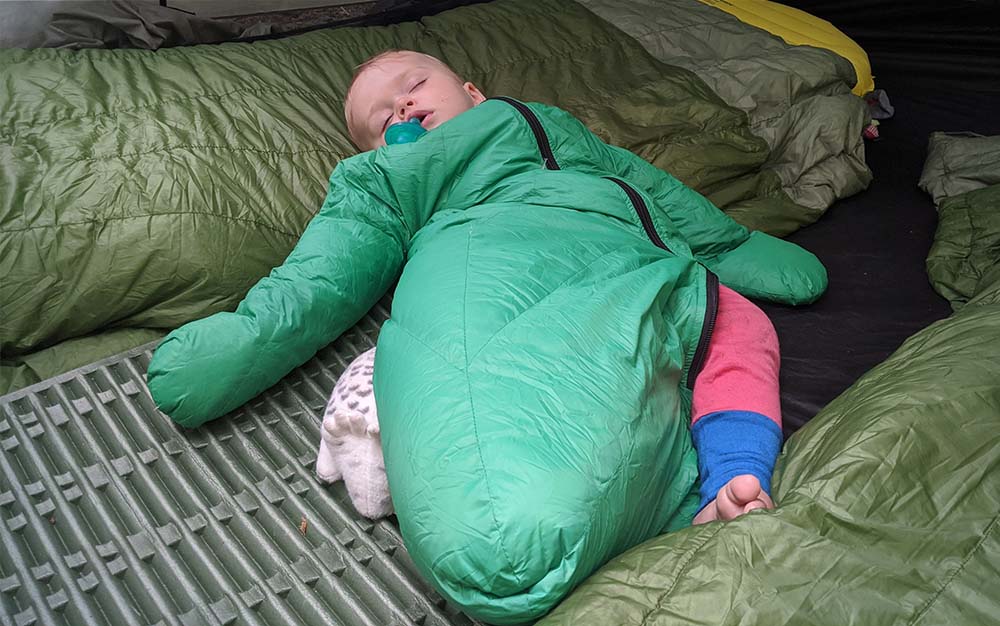
Safe sleep standards with the bonafides to handle serious backpacking conditions put the Morrison Outdoors bags in a class of their own. A must-have for adventuring parents of young children. The Big Mo sleeping bag is designed to create a safe sleep environment for your mini adventurer in rugged outdoor environments. The fitted neck ensures their head won’t slip in the bag, and there are no drawstrings for them to get tangled up in. The two-way zipper stays in place all night, even when they fling themselves over your legs at the bottom of the tent. The closed sleeves leave kids with enough mobility to shift themselves into a comfortable position while they sleep, but not enough to get into trouble with the rest of the gear in your tent.
After multiple nights of alpine testing on Mount Rainier with a toddler that runs cold, we’re confident in the 20 degree rating (if your child runs hot, consider the 40 degree bag instead). Since this bag uses the same fill power (650fp) as most adult backpacking bags, it’s both lightweight and packs down enough to stuff in with your full-size sleeping bag, reducing the space it takes up in your packs. —Laura Lancaster
Best Eco-Friendly Sleeping Bag: Marmot Trestles Elite Eco 20 Sleeping Bag
Key Features
- Regular, Long, and X-Wide (men’s and women’s)
- Tested comfort: 20.3 degrees, tested lower limit: 7.9 degrees
- Weight: 2 pounds, 10.8 ounces (Regular)
- 100% recycled polyester fabric
- Recycled synthetic fill
- Trestles Elite Eco also available in 30 and 0 degrees
- Come with a storage bag and a compression stuff sack
- Backed by lifetime warranty
Pros
- Great for backpacking and car camping
- Super warm footbox
- Six size options between gender and length/width
Cons
- Jack of all trades, master of none: heavier than some backpacking options, you may not prefer a narrower mummy for car camping
The Marmot Trestles Elite Eco 20 Sleeping Bag proves that sustainable gear doesn’t mean sacrificing quality. It’s a sweet spot sleeping bag you can take car camping or backpacking and comes in three temperatures for most conditions. Made with recycled synthetic fibers, the Marmot Trestles Elite Eco 20 Sleeping Bag is my pick for the best eco-friendly bag on the market (at an ultra-competitive price). It comes in Regular, Long, and X-Wide sizes, and is a strong 3-season bag at 20 degrees, with a 30- or 0-degree option. I originally bought the Trestles Elite Eco 20 when I was living in northwest Wyoming, looking for a sustainable bag that was going to check all my boxes during fluctuating night temperatures.
I’ve taken this sleeping bag backpacking and car camping for three years now, and like it because it’s roomy for a backpacking sleeping bag (multiple size options), has a warm footbox, and has a smaller impact than gear made of new materials. It packs down enough to store at the bottom of my backpack, although it’s not my number one choice if weight is my priority. This sleeping bag also comes with a storage bag that doesn’t compress the internal fibers.
If you’re looking to just buy one sleeping bag that can take you from backpacking to a family camping trip, I’d suggest this one. Not only does it have a smaller footprint than something made from all new materials, owning a versatile bag means you can buy less stuff, too. —Samantha Silverman
Best Sleeping Bag for Cold Weather: Wiggy’s Antarctic
Key Features
- Minus 60-degree temperature rating
- Weight: 6.5 pounds
- Regular/Wide, Long/Wide sizes
- Black and multicam color options
- Synthetic Insulation
- Optional waterproof poncho
Pros
- Warm in extremely cold weather
- High quality insulation and construction
- Affordable compared to high-end down bags
Cons
- This bag is huge and heavy
This Wiggy’s bag is probably the coldest-rated sleeping bag on the market and will keep you toasty in almost any winter camping condition. Wiggy’s is known for producing quality sleeping bags and “colorful” customer service. Their bags have long been popular here in Alaska, and if you’re looking for a cold-weather winter camping bag, the Antarctic bag is hard to beat. I don’t know anyone who’s tested it at its 60-below temperature rating, but you’ll be hard-pressed to find a warmer bag.
This bag is advertised at 6.5-pounds, but some of their weight ratings aren’t completely accurate. It’s a heavy bag with an average of 10-inches of loft, so it’s not for backpacking. For winter camping in warmer areas, this might not be the bag for you, but in northern territory, there’s nothing wrong with overkill when it comes to sleeping bags. —Tyler Freel
Key Features
- Weight: Regular: 1 pound 6 ounces
- Long and Regular sizes
- 40-degree temperature rating
- Water-repellent nylon
- Highly compressible
Pros
- Super light and compressible
- Will keep you comfy on warm summer nights
Cons
- Not ideal for cold weather
- Not suited for hardcore mountain trips
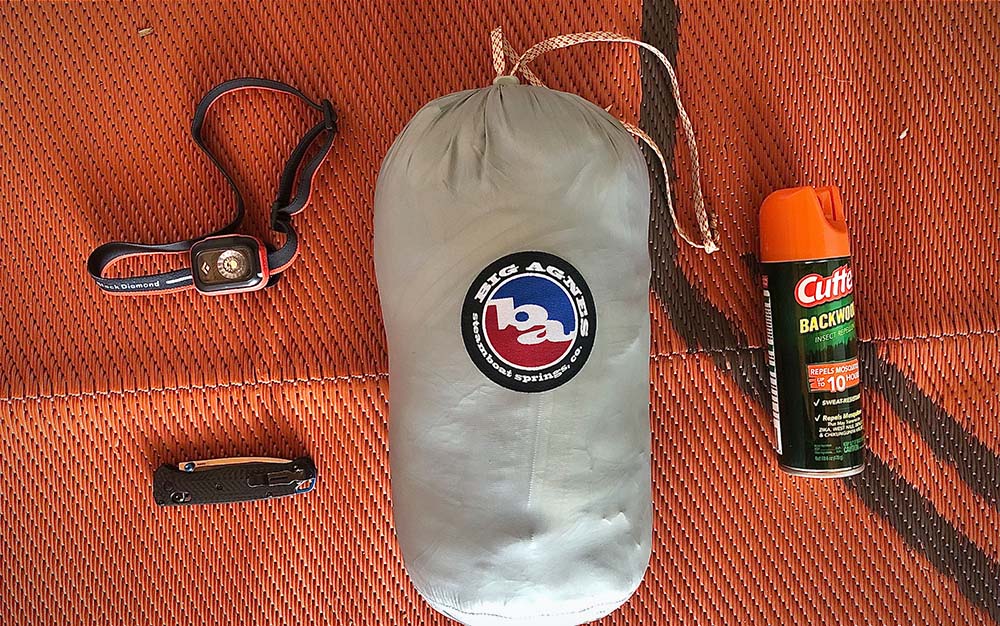
On a warm summer night you don’t need, or want, a heavy sleeping bag. The Big Agnes V Notch is ideal for ultralight backpacking or car camping in hot weather. I run hot. Climbing into a bulky down sleeping bag on a warm summer night after sweating in the sun all day sounds like my idea of hell on Earth. So when nightime temperatures run between 70 and 50 degrees, I’ll opt for the minimalist Big Agnes V Notch. It’s made from water-resistant rip-stop nylon and is stuffed with 70 percent recycled PrimaLoft insulation, which makes it warm enough, but definitely not too warm.
It also has a full-length zipper for better temperature regulation. The hood, which isn’t really shaped like a hood, is fitted with a simple draw cord and doesn’t carry much bulk. The sleeping bag also comes with a storage sack so you don’t have to keep it crammed in the tiny stuff sack all winter. Besides being the best summer sleeping bag, this would also be a good option for ultralight backpackers (in compresses down to about the size of a massive sub sandwich) who know they’re not going to get into inclement weather. I would not take this bag deep into the mountains and expect it to keep me alive during a pop-up blizzard. —Alex Robinson
Key Features
- Weight: 10 pounds
- Rated for 0-60 degrees
- Three removable layers for variable temperatures
Pros
- Big and comfortable
- Add layers when it gets cold and strip them when it’s hot
Cons
- Super heavy
- Not waterproof
- Not for serious outdoor camping
Welcome to deer camp. Your bunk is in the back, above old uncle Larry. And yeah, he snores. We’re going to stoke the wood stove so hot that you’ll be sweating by the time you turn in for bed. But sometime around 1 a.m. those frigid temperatures outside are going to seep into this old shack. By the time your alarm goes off in the morning, you’ll be able to see your breath. Hopefully, you brought your Coleman All-Weather sleeping bag with you.
This bag has three layers that all fit together through a simple loop/anchor system. On the very inside is a fleece blanket, then a light inner bag, and finally a heavier blue outer bag. Mix and match these layers for maximum comfort depending on the temp. If it’s really warm, just lay on top of the bag and pull the fleece over you. If it’s chilly, snuggle in beneath all three layers.
Coleman says this sleeping bag system is rated to 0 degrees, but do not bring this bag camping in 0-degree conditions. You will be cold. The only other downside to this bag is its colossal size and weight. It’s comparable to 10 of the Big Agnes V Notch sleeping bags. But hey, you’re just hauling it from your truck into the cabin, so who cares about weight. The bag is so hefty that it comes with a carrying case, which is about the size of a large soft-sided cooler. Throw some earplugs in the case (to muffle uncle Larry’s snoring) and you’ll be ready for deer camp. —Alex Robinson
Things to Consider
Sleeping Pad
Reviews of sleeping bags are littered with complaints that they weren’t warm enough or didn’t live up to the temperature rating, but unfortunately these reviews mean nothing if you don’t know what R-value sleeping pad they were using. That’s because sleeping bags will not perform up to their temperature rating unless they are paired with a sleeping pad that has an R-value of 4 or higher. An R (for resistance) rating measures how well a sleeping pad prevents (or resists) the cold of the ground from creeping through to the side you are sleeping on. Low R values provide little to no resistance while high R values resist even subfreezing temperatures. —Ashley Thess
Read Next: What is R Value? It’s Why Your Sleeping Bag Doesn’t Keep You Warm
Temperature Rating
The first thing you need to know about a sleeping bag’s temperature rating is that there isn’t going to be just one number: There is a “comfort” temperature, a “lower limit” or “transition” temperature, and a “risk” or “extreme” temperature. The comfort number is what it sounds like—this is the temperature at which you’re the most likely to actually be comfortable. The “limit” or “transition” temperature is when you will start to feel uncomfortable—you’re not shivering necessarily, but you’re not sleeping well either. The “risk” temperature is the temperature at which you are in danger of hypothermia.
The tricky part is that the advertised temperature rating for a sleeping bag is sometimes the comfort temperature and sometimes the transition or lower limit rating. Women’s bags are more likely to list the comfort temperature rating, as opposed to the limit rating (manufacturers generally assume that women run colder than men), but this varies by brand: Always check the fine print before committing to a purchase.
The good news about these temperature ratings is that they aren’t based on the personal opinions of the manufacturers—there is an actual standard that the temperature of a sleeping bag is judged on (two, in fact). Sleeping bag temperature ratings are assessed using a heat-producing manikin with temperature sensors placed inside of a climate controlled room on top of a 4.8-R rated sleeping bag—I’m vastly paraphrasing here, but you get the idea of what an intense process this is. The upshot of all this effort on the part of the sleeping bag manufacturers is that if you know your ISO-rated or EN-rated 30-degree bag is the right temperature for you, you can be reasonably confident in purchasing a 30-degree bag from a different manufacturer.
The downside is that the temperature ratings are just that: ratings. Human bodies are different, and only you know if you are cold, hot, or surface-of-the-sun hot. If you run cold, go with at least 10 degrees warmer than you think you need. —Laura Lancaster
Gender
Most of the time, the difference between a men’s sleeping bag and a women’s sleeping bag is just about the size and shape (and, too often, the color), but sometimes there are differences in where and how the bag’s insulation is concentrated to reflect the differences in how men and women dispel heat. The advertised temperature rating is also typically a comfort rating for women’s bags and a limit rating for men’s bags. —Laura Lancaster
Fill
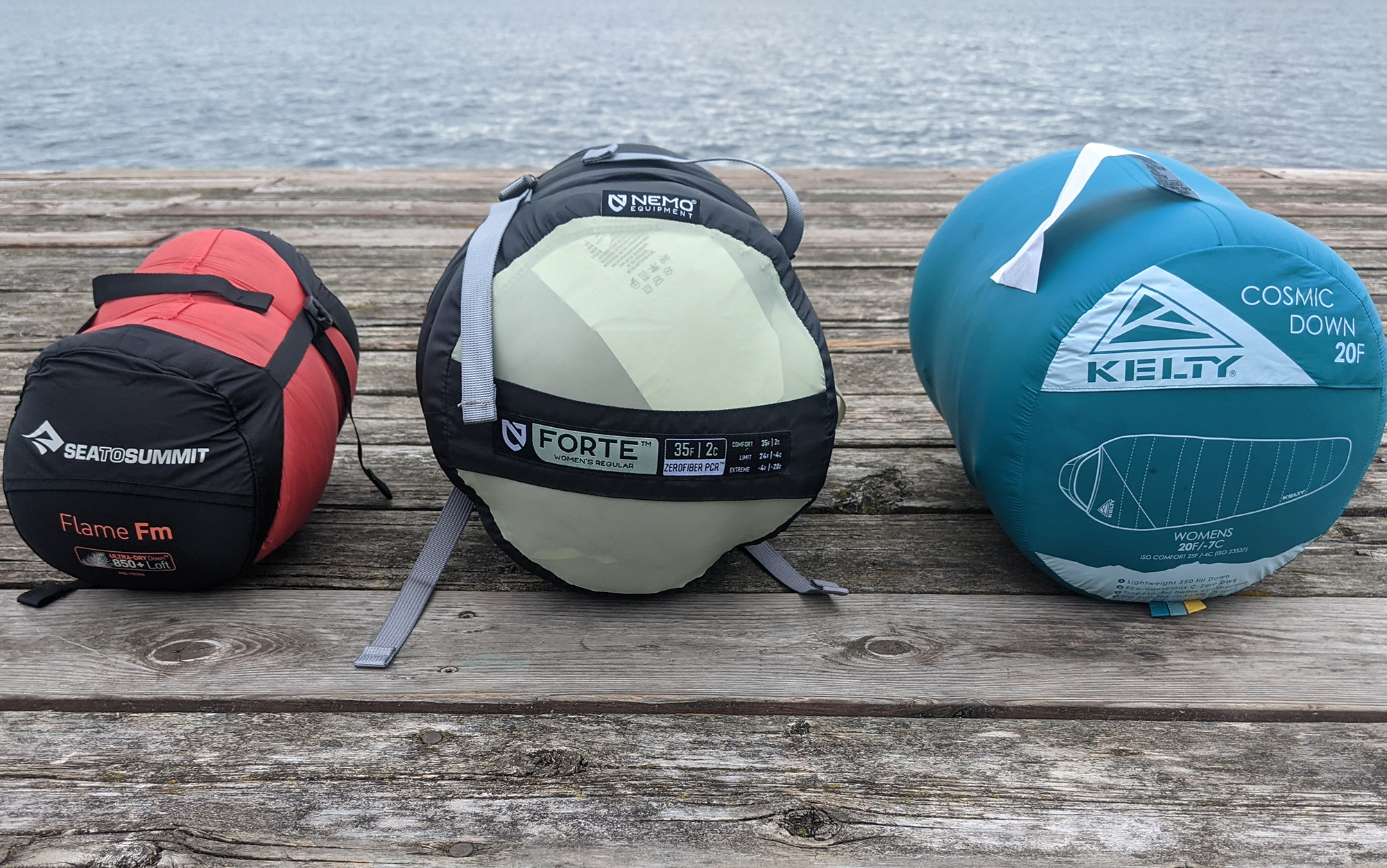
I’ll be honest with you; backpackers can debate the down versus synthetic fill of sleeping bags until they’re blue in the face. If you’d like to get to know the intricacies of this valid debate, by all means, dive in: Down vs Synthetic Sleeping Bags. But I’m going to lay it out from a practical buyer’s standpoint.
Down is superior in its warmth to weight ratio, but it’s also more expensive. Down detractors will say that it won’t perform when wet and there are environmental concerns about the treatment of the animals it comes from. In reality, most (be sure to check) down bags are treated to be hydrophobic. This treatment can wear off, not all treatments are created equal, and it will require a special detergent to preserve this hydrophobic quality. But it works. There is also a Responsible Down Standard certification that signifies responsibly sourced down. I highly encourage you to verify an RDS-certification before purchasing any down product.
Synthetic is cheaper and performs when wet, no treatment necessary. —Ashley Thess
FAQs
Q: How do I choose a sleeping bag?
There are three factors to consider when choosing a sleeping bag: warmth, sleep style, and activity. We recommend choosing a bag that is warm enough to handle the most extreme colds you expect to encounter, as it is always a safer bet to unzip a bag than to pile on extra clothing. Next is sleep style. Back sleepers may appreciate the profile of a mummy bag, while side sleepers would fare better with a quilt. Finally, if you are planning a backpacking trip, carefully consider the tradeoffs of weight and packed size before purchasing a sleeping bag.
Q: What temperature rating should I look for in a sleeping bag?
The temperature ratings provided by sleeping bag manufacturers can be imperfect, and it would be unwise to expect a 30-degree bag to keep you warm when temperatures dip below freezing. If you only plan to use your bag during the summer, a 30-degree bag is a good bet, while a 20-degree bag is appropriate for most shoulder-season activities. If you plan to do winter camping, or live in a more extreme temperate zone, consider a 10- or 0-degree bag (or check out our cold-weather pick). Keep your own preferences in mind—a bag that is warm enough for another person might be too cold for you—and be sure to pick a sleeping pad with an appropriate R rating.
Q: Should I choose a sleeping bag with synthetic or down fill?
The biggest difference between sleeping bags is often down versus synthetic fill. Both synthetic and down fill can keep you warm in extreme conditions—where they vary is in how much insulation is needed to reach the same temperature rating, and how much space they take up when packed. Less expensive synthetic fills can make affordable sleeping bags that are suitable for car camping. The highest fill power down (800fp and up) is used for ultralight sleeping bags that are typically fairly expensive and used for multi-night backpacking trips or thru-hikes. High quality synthetic fill and lower fill power down tend to meet in the middle, and are suitable for overnights and basecamps.
Final Thoughts
The best sleeping bags on the market will keep you warm and dry no matter what conditions you’re camping in. The flipside, of course, is that these bags are expensive. If you’re planning true backcountry adventures, an expensive bag is worth it. Typically have a higher warmth-to-weight ratio which will save ounces from your pack, and could also save your life if you’re caught in treacherous weather.
If you’re planning more frontcountry outings in warmer weather, look for bargain bags that will be comfortable. But even for frontcountry campers, bigger (and bulkier) isn’t always better. We get accustomed to giant beds, fluffy pillows, and plush comforters in our everyday lives, but I’ve had my best night’s sleep ever curled up in a mummy bag using a rolled up jacket as a pillow. Even on family car camping trips, practice getting comfortable with lighter gear and less of it. That goes for your sleeping bags, pads, and pillows as well.

